Highlights from the Pacific Islands Collection on the Web
In the spirit of recent discussions about making our collection more available to view online, I wanted to take this opportunity to highlight a small but important cache of updated photographs and information relating to our Pacific Islands collection.
The islands of the Pacific Ocean are divided into four major cultural regions: Polynesia (“many islands”), Melanesia (“black islands”), Micronesia (“small islands”) and the islands of Southeast Asia. The Museum’s first-floor galleries currently display highlights from its collection of the arts of Polynesia and Island Southeast Asia. The existing installation includes some small but spectacular gems.
From Polynesia, a moko miro figure from Rapa Nui (Easter Island), for example, combines lizard, avian and human characteristics into a form whose past use is still debated among scholars.
Lizard Figure (Moko Miro), unidentified Rapa Nui artist. 19th century, Rapa Nui (Easter Island), Chile. Wood. 15 3/4 x 3 x 2 in. (40 x 7.6 x 5.1 cm) Museum Expedition 1941, Frank L. Babbott Fund, 41.1277.
The enigmatic and thoroughly engaging figure from the Nicobar Islands (actually located in the eastern Indian Ocean), is possibly a henta-koi, or “scare devil,” intended to keep malevolent spirits at bay. The figure stands as an exceedingly rare highlight of the collection—not only is it quite compelling on a formal level, but it also remains one of perhaps less than a handful of such sculptures known.
Figure, unidentified Nicobar Islands artist. 19th century, Nicobar Islands, Union Territory of Andaman and Nicobar Islands, India. Wood, shell, pigment. 29 x 17 1/2 x 25 1/2 in. (73.7 x 44.5 x 64.8 cm). Ella C. Woodward Memorial Fund and the Museum Collection Fund, 63.57.
However, our complete collection of Pacific Islands art goes well beyond what is currently on display. The current, 1st Floor gallery is a remnant from a larger installation that once included part of the space formerly occupied by the Hall of the Americas. The Pacific collection also includes tapa cloths, jewelry, decorated weapons, and ceramic bowls, but the preponderant emphasis is on ceremonial sculpture, especially from Papua New Guinea. The arts of Melanesia—especially the Sepik River region of New Guinea, as well as New Ireland and Vanuatu—are well-represented. One of the great benefits of the Web, from the point of view of permanent collection stewardship, is the ability to keep such works in the public eye.
Mask (Kavat), unidentified Baining artist. Late 19th or early 20th century, Gazelle Peninsula, East New Britain Province, Papua New Guinea. Bark cloth, pigment, cane. 50 x 11 x 29 in. (127 x 27.9 x 73.7 cm). Gift of Thomas and Katherine Brush, 1994.142.
The breadth of our Melanesian collection, in particular, merits further exploration. The Baining mask, is an exceedingly expressive masquerade genre, danced at night amid roaring fires and drumming. A tatanua mask, from New Ireland, is one of a rich sub-collection of objects related to the malagan funerary complex.
Mask (Tatanua), unidentified New Ireland artist. 19th century, New Ireland Province, Papua New Guinea. Wood, rattan, bark cloth, fiber, Turbo petholatus opercula, pigment. 15 1/4 x 9 x 12 in. (38.7 x 22.9 x 30.5 cm). Brooklyn Museum Collection, X1033.
Finally, this headdress, from the Huli people of the Highlands region of Papua New Guinea, remains a spectacularly ostentatious example of the modes of self-presentation, including body painting and feather headwear, that prevail in that region. (This headdress would have been worn on ceremonial occasions, such as dances, or by an initiate of a bachelors’ society.)
Headdress and Headband, unidentified Huli artist. 20th century, western region, Southern Highlands Province, Papua New Guinea. Human hair, feathers, cuscus fur, porcupine quills, reptile skin, dried flowers, button, string. 18 x 15 3/4 x 7 in. (45.7 x 40 x 17.8 cm). Gift of Marcia and John Friede and Mrs. Melville W. Hall, 87.218.64a-b.
These are a small sample of the sorts of highlights that, with the help of Katie Apsey, Curatorial Assistant, our team in the Registrar’s office and the Digital Lab, are now available to peruse on the site. Come check out our 1st floor gallery, and then explore further online.

Kevin D. Dumouchelle joined the Brooklyn Museum in 2007. He was promoted to Associate Curator for the Arts of Africa and the Pacific Islands in 2012, having served as Assistant Curator since 2008. In 2011 he conceived and curated African Innovations, the Museum’s first chronological and contextual installation of its African collection. He has also curated a number of exhibitions, and contributed to the writing and editing of a major catalogue of works in the African collection, African Art: A Century at the Brooklyn Museum, published by the Brooklyn Museum in association with DelMonico Books • Prestel in fall 2009. Dumouchelle has published on a range of topics, from architecture and canonical African sculpture to contemporary photography, and he has received numerous fellowships and awards. Dumouchelle earned an M.A. and M.Phil. in Art History and Archaeology from Columbia University, where he taught art history and is completing his Ph.D. He has pursued research in Morocco, Mali, and Ghana, and is the recipient of a first-class Master’s degree in history from Oxford University and a B.S. in Foreign Service from Georgetown University.





